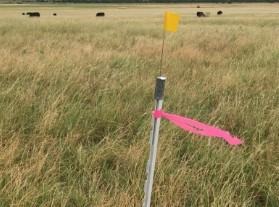By Eric Hamilton
The Great Plains in the United States are well known for a rich history and expansive grasslands. This region is synonymous with ranchers herding cattle across the plains and a valuable resource for a growing population.

Soil greenhouse gas monitoring chamber, mid-season. The photo was taken at a native tallgrass prairie site at Grazinglands Research Laboratory in El Reno, Oklahoma. The study focused on monitoring three major greenhouse gas sources – carbon dioxide, methane, and nitrous oxide.
Today, that work continues. Huge tracts of prairie still support livestock, especially cattle. The land might not be as well-suited for growing grain or vegetables, but grasslands can contribute to feeding people by feeding animals first. Like all types of agriculture, grazing on prairies has an environmental impact. Scientists, farmers, ranchers, and consumers are increasingly trying to balance food production and protecting the environment, so it is important to understand how one affects the other.
“Increases in carbon dioxide and other greenhouse gases in the earth’s atmosphere greatly affect climate around the world,” says Jean Steiner. Steiner directed the U.S. Department of Agriculture’s grazing laboratory in Oklahoma. “Agricultural land exchanges greenhouse gases with the atmosphere, and how we manage agriculture affects the amount of greenhouse gas exchange.”
Steiner and her team recently set out to understand the impacts of greenhouse emissions from grasslands. Only with this knowledge can scientists hope to steer agriculture toward climate-friendly solutions.
This study was published in Agrosystems, Geosciences & Environment Journal, a publication of the American Society of Agronomy, and Crop Science Society of America.

As detailed in the research, Steiner’s team studied four pastures in Oklahoma. Three of the pastures were native prairies. One was a planted pasture made up of a single species of Old World bluestem grass. Unlike the planted pasture, the native prairies host many species and receive less fertilizer.
The scientists were especially interested in three major greenhouse gas sources. Carbon dioxide is perhaps the most well-known. However, methane and nitrous oxide are even more powerful at trapping heat, so it is key to understand how much of these gases are emitted too.
“These processes are not well-understood in grasslands used for grazing livestock, which can lead to lost opportunities to improve the systems. There is also misunderstanding by consumers about the role of agroecosystems in the global challenges of climate change,” says Steiner.
The team found that in this hot, subhumid area, all the sites emitted carbon dioxide. Plants absorb this gas when they are growing. But during the rest of the year, enough carbon dioxide is given off to make the grasslands net emitters. As the climate becomes hotter and drier, maintaining a net uptake of carbon dioxide becomes more challenging. The biggest differences between sites came from nitrous oxide and methane. “All sites emitted small amounts of nitrous oxide, and the non-native site, which received fertilizer application, emitted the largest amount of nitrous oxide,” says Steiner. With nitrous oxide being three hundred times stronger at trapping heat than carbon dioxide, this difference really adds up.
Click here to see more...